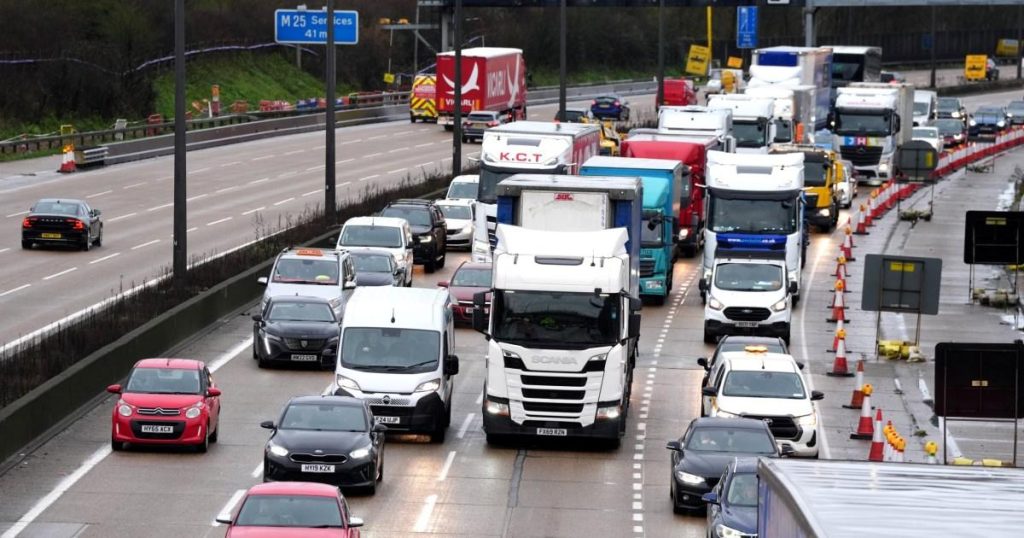Traffic Chaos in London and Southern England: M25 Closure, Gatwick Train Fire, and Widespread Flooding
London commuters faced a trifecta of travel disruptions on January 6, 2025, as a combination of a major motorway closure, a train fire at Gatwick Airport, and extensive flooding across southern and central England brought transport networks to their knees. The M25, a vital artery circling London, was closed anti-clockwise between Junction 10 (A3) and Junction 8 (Reigate) due to overnight resurfacing work necessitated by a lorry crash. While no injuries were reported in the accident itself, the closure caused significant delays for motorists throughout the day, with all four lanes remaining shut past the initially estimated reopening time of 3 pm. Adding to the travel woes, one lane was also closed clockwise between Junctions 8 and 9, further exacerbating congestion.
Gatwick Airport, a major international hub south of London, experienced its own set of disruptions when a train caught fire at the airport’s railway station around 12:30 pm. The "small fire," believed to be caused by an electrical fault, prompted the evacuation of passengers from the train and the platform into the South Terminal. While the fire was quickly extinguished and no injuries were reported, the incident led to the closure of the station, preventing other trains from stopping. Though the station eventually reopened, residual delays and cancellations rippled through train services, impacting travelers heading to and from the airport, with disruptions expected to last until 6 pm. Gatwick Express services remained suspended, while Thameslink services operated on a reduced schedule with added stops to mitigate the impact of the station closure.
The transportation mayhem was further compounded by widespread flooding across southern and central England, with particularly severe impacts in Kent, Hampshire, and Surrey. The heavy rainfall caused road closures and disruptions to train services, stranding some motorists and further complicating travel plans. Images emerged of submerged vehicles and flooded roads, highlighting the extent of the disruption caused by the inclement weather. The flooding also impacted areas like Yalding, Kent, where a stranded car vividly illustrated the challenges faced by residents and travelers. Meanwhile, snow further north added another layer of complexity to the already challenging travel conditions across the country.
Beyond the immediate travel disruptions, the day brought news of other incidents and developments affecting transportation. A new road tunnel, the Silvertown Tunnel, connecting Silvertown and Greenwich Peninsula in east London, was announced to open on April 7, 2025. This project aimed to alleviate congestion at the Blackwall Tunnel, though new tolls would be implemented on both tunnels. Elsewhere, a report highlighted the disproportionate impact of bus service cuts on deprived areas of England, illustrating the social and economic consequences of reduced public transport access. Tragic news also emerged from Lincolnshire, where a seven-year-old girl involved in a car crash succumbed to her injuries, and from the M180, where a woman was killed and a two-year-old critically injured in a crash involving a suspected drunk driver.
The day’s events underscored the vulnerability of transportation networks to a confluence of unforeseen events. The combined impact of the M25 closure, Gatwick train fire, and flooding created a perfect storm of travel disruption, highlighting the interconnectedness of different modes of transport and the importance of robust contingency plans. From major motorways to local roads and rail lines, the disruptions rippled across the region, affecting countless commuters, travelers, and residents. The incidents also served as a stark reminder of the need for investment in resilient infrastructure and emergency response capabilities to mitigate the impact of such events in the future.
The unfolding events on January 6, 2025, provided a real-time case study in the complexities of managing transportation networks in the face of multiple challenges. From the logistical hurdles of diverting traffic around the M25 closure to the emergency response efforts at Gatwick Airport and the ongoing efforts to address the widespread flooding, the day’s events demanded coordinated action from various agencies and authorities. The incidents also highlighted the human cost of such disruptions, from the inconvenience experienced by stranded travelers to the tragic loss of life in road accidents. As the day drew to a close, the focus shifted to restoring normalcy to transportation services and addressing the underlying issues that contributed to the widespread disruptions. The long-term implications of these events, including the need for improved infrastructure resilience and enhanced emergency preparedness, remained to be addressed in the days and weeks to come.


